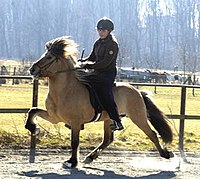
Photo from wikipedia
Accurate prediction of intended gait speed is crucial for facilitating volitional muscle activity during robot-assisted gait training. Considering that most patients find it difficult to perform gait at relatively high… Click to show full abstract
Accurate prediction of intended gait speed is crucial for facilitating volitional muscle activity during robot-assisted gait training. Considering that most patients find it difficult to perform gait at relatively high speeds, it is also imperative that the prediction model performs well at slow gait speed. Furthermore, ample time for signal processing should be given prior to robot assistance such that the patient is not subjected to unwanted resistance or lag. Here, the authors propose to predict the intended speed of the contralateral limb via kinematics of the current swing limb. Three lower-limb positions were evaluated using an inertial measurement unit sensor during treadmill gait sessions. The results suggest that the authors’ model performs well even during slow gait speeds ( ≤ 2 km / h ) with R 2 values as high as 0.86.
Journal Title: Electronics Letters
Year Published: 2020
Link to full text (if available)
Share on Social Media: Sign Up to like & get
recommendations!